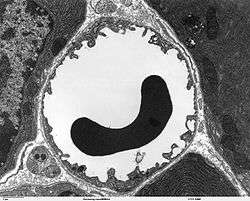Microvessel
| Microvessels | |
|---|---|
 A rhesus macaque cortical microvessel stained for focal adhesion kinase (green), zonula occludens 1 (red) and endothelial nuclei (blue). Image by Nathan S. Ivey, PhD and Andrew MacLean, PhD. | |
 Transmission electron microscope image of a capillary with a red blood cell within the pancreas. The capillary lining consists of long, thin endothelial cells, connected by tight junctions. | |
| Identifiers | |
| Code | TH H3.09.02.0.02001 |
Microvessel or microvasculature refers to the smallest systems of blood vessels in a body, including those responsible for microcirculation, the system of smaller blood vessels that distribute blood within tissues. Common examples of microvessels include:
- Arterioles, a small diameter blood vessel that extends and branches out from an artery and leads to capillaries
- Capillaries, the smallest blood vessels
- Metarterioles, a vessel that links arterioles and capillaries
- Venules, a blood vessel that allows deoxygenated blood to return from the capillary beds to the larger blood vessels called veins
- Thoroughfare channel, a venous vessel receiving blood directly from capillary beds. It is a tributary to venules

References
This article is issued from Wikipedia - version of the 3/19/2016. The text is available under the Creative Commons Attribution/Share Alike but additional terms may apply for the media files.